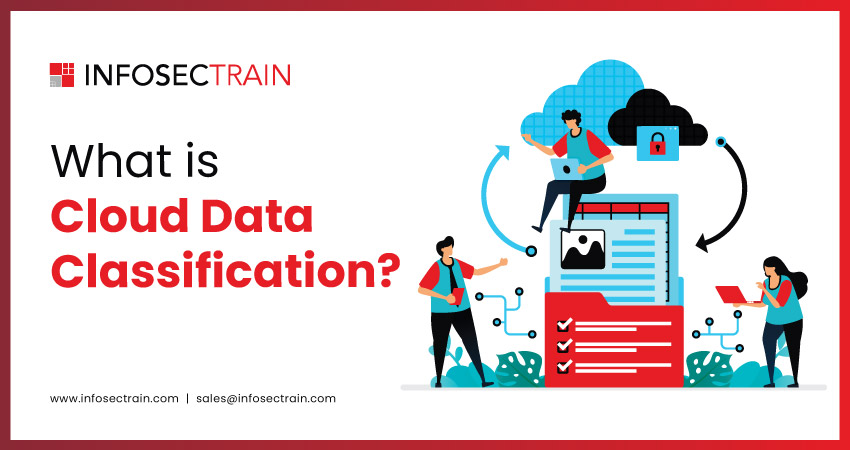What is Cloud Data Classification?
Cloud data classification is fundamental to modern data management, mainly as organizations migrate to cloud environments. Effective data classification strategies have become imperative as businesses recognize the critical importance of safeguarding sensitive information. In this article, we explore the concept of cloud data classification, its significance in ensuring data security and compliance, and practical techniques for implementation. By mastering cloud data classification, organizations can protect their digital assets, mitigate risks, and adapt to evolving regulatory landscapes.

What is Cloud Data Classification?
Cloud data classification involves identifying, categorizing, and labeling data stored in cloud environments, considering its sensitivity and business significance. This practice enables organizations to assess the potential risks linked with various data types and apply tailored security measures accordingly. By comprehensively classifying data, businesses can better prioritize protection efforts, ensuring that valuable assets are safeguarded from unauthorized access and possible breaches within cloud environments.
Importance of Cloud Data Classification
1. Enhancing Security:
Organizations categorize data by sensitivity, concentrating security efforts on critical information. This facilitates the strategic allocation of resources, enforcing robust controls such as encryption and access restrictions for susceptible data while employing less stringent measures for less vital information. Identifying and classifying sensitive data empowers organizations to anticipate threats and vulnerabilities, fostering proactive risk mitigation strategies against data breaches, unauthorized access, and other security incidents.
2. Efficient Data Management:
Data classification establishes consistent data governance policies and procedures. Understanding data classification enables organizations to define access controls, retention policies, and disposal procedures. Improved insights into data types and values facilitate informed storage, usage, and sharing decisions. This empowers organizations to tailor their data management practices based on sensitivity and business impact.
3. Improved Compliance:
Regulations such as GDPR and HIPAA require precise data protection measures. Data classification clarifies which data is subject to these regulations, enabling the implementation of compliant controls. This mitigates legal risks and fines due to non-compliance. A documented data classification system showcases accountability in data handling, fostering trust with stakeholders and regulatory bodies.
4. Reduced Costs:
Effective data classification prevents unnecessary security overspending by directing resources to protect critical information. Organizations allocate funds more efficiently by prioritizing protection efforts based on data sensitivity. This targeted approach ensures that essential security measures are applied where they are most needed, reducing overall costs. Additionally, streamlined data management processes resulting from classification efforts can lead to operational efficiencies and cost savings.
5. Improved Efficiency:
Streamlined data management processes, guided by classification, save time and resources. By categorizing data, organizations can prioritize tasks and allocate resources effectively. This focus on core business activities enhances productivity and reduces operational overhead. Standardized procedures resulting from classification efforts promote workflow consistency and clarity, improving efficiency.
Key Steps Involved in Cloud Data Classification
1. Define Classification Levels:
Define highly confidential, confidential, internal, and public sensitivity levels based on legal requirements, business impact, and potential harm from breaches. Characteristics and criteria such as data type, content keywords, origin, and access restrictions should categorize data into each level. This structured approach ensures appropriate handling and data protection according to sensitivity, minimizing risks and aligning with organizational needs.
2. Data Discovery and Inventory:
Identify and map all cloud storage services and applications housing data spanning public, private, and hybrid environments. Develop a detailed inventory detailing data location, format, size, and ownership to grasp the extent of classification needs. This comprehensive approach facilitates effective data management and classification strategies, ensuring thorough coverage and understanding of data assets.
3. Data Classification:
Employ user-driven workflows for manual assessment and labeling of data by employees, ideal for smaller datasets or sensitive information. Utilize automated tools and services employing predefined rules or machine learning algorithms to scan and analyze data content, ensuring efficient classification of large datasets with reduced manual effort. This dual approach combines user expertise with automated efficiency, enhancing accuracy and scalability in data classification processes.
4. Labeling and Tagging:
Consistently apply labels or tags to classified data, indicating sensitivity levels and associated controls for easy identification and management. Integrate data classification tools with cloud storage platforms to automatically assign labels during data upload or access, streamlining the process and ensuring uniform labeling. This approach enhances data organization, simplifies retrieval, and reinforces security measures by maintaining consistency across the data lifecycle.
5. Ongoing Management and Governance:
Regularly review and update the classification scheme and criteria to align with evolving regulations, business requirements, and data landscapes. Establish strong policies and procedures for data handling, access control, retention, and disposal tailored to each classification level. Educate employees on the significance of data classification, clarifying their roles, responsibilities, and appropriate handling protocols for various data types.
Challenges Involved in Cloud Data Classification
1. Complexity of Data Distribution: Data scattered across multiple cloud services, private clouds, and on-premises systems poses discovery, inventorying, and classification challenges. With diverse data formats—structured, unstructured, and semi-structured—practical classification demands tailored approaches and tools for comprehensive management.
2. Accuracy and Consistency: Manual classification is error-prone, leading to data consistency and misclassifications, which can result in security and compliance issues. Continuous monitoring and reclassification efforts are necessary to ensure accuracy as data sensitivity and content evolve.
3. Automation Challenges: Though efficient for large datasets, automated tools may need help with context-specific data, leading to false positives and negatives. Biased training data can perpetuate algorithm biases, resulting in inaccurate and discriminatory classification outcomes.
4. Integration and Governance: Integrating data classification tools with diverse cloud storage platforms and security systems is complex and requires continual maintenance. Weak data governance policies can compromise classification effectiveness, leading to non-compliance and security vulnerabilities.
5. User Adoption and Awareness: Complex classification schemes and unclear labeling can confuse users, leading to inconsistent application of rules. Resistance to new procedures may stem from perceived inconvenience or a lack of understanding of their significance.
Cloud Computing with Infosectrain
InfosecTrain provides invaluable insights into the importance of grasping the potential benefits of your cloud investment. Evaluating storage servers or similar innovations should prioritize their impact on end users. Organizations leveraging cloud-based data networks require assurance of uninterrupted operations in the face of server failures, security breaches, or human errors. For a deeper understanding of Cloud Computing, consider exploring InfosecTrain’s resources. Their expertise can equip you with the insights to optimize your cloud infrastructure and effectively mitigate risks.
TRAINING CALENDAR of Upcoming Batches For
| Start Date | End Date | Start - End Time | Batch Type | Training Mode | Batch Status | |
|---|---|---|---|---|---|---|
| 31-May-2025 | 02-Aug-2025 | 19:00 - 23:00 IST | Weekend | Online | [ Open ] | |
| 28-Jun-2025 | 30-Aug-2025 | 09:00 - 13:00 IST | Weekend | Online | [ Open ] | |
| 26-Jul-2025 | 27-Sep-2025 | 19:00 - 23:00 IST | Weekend | Online | [ Open ] | |
| 16-Aug-2025 | 25-Oct-2025 | 19:00 - 23:00 IST | Weekend | Online | [ Open ] |







 1800-843-7890 (India)
1800-843-7890 (India)